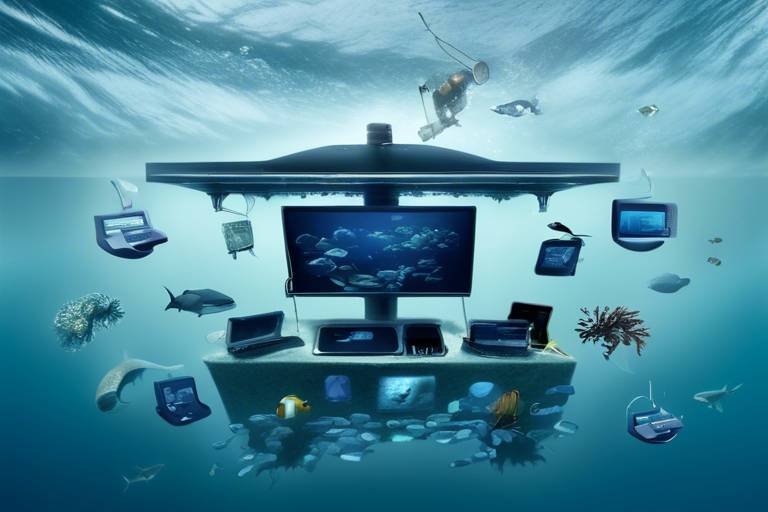The Intersection of Technology and Marine Biology
In the vast, mysterious world beneath the waves, marine biology is undergoing a remarkable transformation, thanks to the rapid advancements in technology. Imagine diving into the depths of the ocean without getting wet, or having the ability to track the movements of a whale across the globe in real-time. These are not just dreams; they are becoming a reality as technology and marine biology converge in exciting ways. This intersection is not only enhancing our research methods but is also revolutionizing conservation efforts and deepening our understanding of complex ocean ecosystems.
As we explore this fascinating synergy, it’s essential to recognize the profound implications it has for our planet. The oceans cover over 70% of the Earth’s surface and are home to millions of species, many of which remain undiscovered. With the help of cutting-edge tools and techniques, marine biologists can now gather data more efficiently than ever before, uncovering secrets that were once hidden in the depths. This article will delve into the innovative research tools that are reshaping marine biology, the role of big data and AI in data collection and analysis, and how technology is pivotal in conservation efforts.
Furthermore, we will look at how technology fosters public engagement and education, making marine biology more accessible to everyone. By utilizing interactive platforms, virtual reality, and citizen science initiatives, we can inspire a new generation to appreciate and protect our oceans. As we navigate through these advancements, it’s clear that the future of marine biology is not just about understanding the ocean but also about preserving it for generations to come.
So, buckle up as we dive into the depths of innovation and explore how technology is shaping the future of marine biology!
- How is technology used in marine biology?
Technology is used in various ways, including advanced research tools like drones and underwater robots, data analysis through AI, and remote sensing technologies for tracking ocean health. - What are the benefits of using drones in marine biology?
Drones provide a cost-effective way to conduct aerial surveys, allowing researchers to map marine habitats and monitor changes without disturbing the local ecosystems. - How does big data impact marine conservation?
Big data allows researchers to analyze vast amounts of information, leading to better monitoring of marine life and more informed conservation strategies. - What role does public engagement play in marine biology?
Public engagement through citizen science initiatives and educational platforms fosters a greater understanding of marine ecosystems, encouraging community involvement in conservation efforts.

Innovative Research Tools
The world of marine biology is undergoing a remarkable transformation, thanks to the advent of . These tools, which include everything from drones to underwater robots, are revolutionizing the way scientists explore and study our oceans. Imagine being able to survey vast stretches of ocean without ever getting wet! This is not just a dream; it's a reality made possible by cutting-edge technology. The efficiency and precision of these tools allow researchers to collect data in ways that were previously unimaginable, enabling them to explore marine environments that were once considered inaccessible.
Drones, for instance, are not only used for aerial photography but also for monitoring marine life and habitat changes. Equipped with high-resolution cameras and sensors, they can capture detailed images of coastal areas and marine ecosystems. This means that researchers can quickly assess the health of coral reefs or track the movement of marine animals without disturbing their natural habitats. Underwater robots, on the other hand, can dive deep into the ocean, exploring the dark, mysterious depths that are home to countless undiscovered species. These robots are equipped with advanced sensors that can measure temperature, pressure, and even chemical compositions of the water, providing invaluable data for scientists.
Furthermore, the integration of these technologies has led to the development of sophisticated software that can analyze the data collected. For example, researchers can use machine learning algorithms to process images captured by drones, identifying species and assessing biodiversity in real-time. This not only saves time but also enhances the accuracy of the data collected, leading to better-informed conservation strategies. The combination of remote sensing and robotics is paving the way for a new era of marine research, where data collection is faster, more efficient, and less invasive.
As we look ahead, the potential for these innovative research tools seems boundless. With ongoing advancements in technology, we can expect even more sophisticated devices that will push the boundaries of marine biology. Imagine a future where scientists can deploy autonomous underwater vehicles that can communicate with each other, sharing data in real-time and creating a comprehensive picture of marine ecosystems. This level of collaboration and data integration could lead to groundbreaking discoveries and a much deeper understanding of our oceans.
In conclusion, the use of innovative research tools is not just enhancing the efficiency of marine biology research; it is fundamentally changing how we interact with and understand the ocean. As technology continues to evolve, we can only anticipate the incredible insights and discoveries that await us beneath the waves.

Data Collection and Analysis
The integration of big data and artificial intelligence (AI) in marine biology is nothing short of revolutionary. Imagine standing on the shore, gazing out at the vast ocean, and knowing that beneath the surface lies a treasure trove of data just waiting to be explored. With these advanced technologies, researchers can analyze vast amounts of information, improving their ability to monitor marine life and environmental changes like never before. It's like having a superpower that allows scientists to see patterns and trends that were previously invisible to the naked eye.
One of the most exciting aspects of this technological advancement is how it enables marine biologists to collect and interpret data with unprecedented efficiency. For instance, researchers can gather information from various sources, including underwater sensors, satellite imagery, and field observations, and then harness AI algorithms to analyze this data. This process not only speeds up research but also enhances the accuracy of findings. It's akin to having a personal assistant that organizes and processes your thoughts, allowing you to focus on the bigger picture.
Remote sensing technologies, including satellite imagery, play a crucial role in tracking ocean temperature, currents, and biological activity. These tools provide scientists with valuable insights into global marine health. For example, satellite monitoring enables scientists to observe large-scale ocean phenomena such as algal blooms and coral bleaching. By analyzing these phenomena, researchers can develop essential data for conservation strategies.
Through satellite monitoring, scientists can gather information over vast distances, making it possible to observe changes in ocean conditions that might otherwise go unnoticed. This data is crucial for understanding how climate change impacts marine ecosystems. For instance, when ocean temperatures rise, it can lead to coral bleaching, which devastates coral reefs and the myriad of species that rely on them. The ability to track these changes in real-time allows for timely interventions and conservation efforts.
Aerial surveys using drones are another fascinating application of technology in marine biology. These drones allow for detailed mapping of marine habitats, helping researchers assess biodiversity and the impact of human activities on these ecosystems. Imagine soaring above a coral reef and capturing high-resolution images that reveal the intricate details of the underwater world. This kind of data collection is not only efficient but also minimizes the disturbance to marine life, making it a win-win for researchers and the environment.
Advancements in genomic technologies, such as DNA sequencing, are transforming our understanding of marine species. This technology facilitates species identification and tracking genetic diversity, which is essential for conservation efforts. By analyzing the genetic material of marine organisms, researchers can gain insights into their population dynamics, migration patterns, and resilience to environmental changes. It's like having a genetic roadmap that guides conservation strategies and helps ensure the survival of vulnerable species.
In conclusion, the fusion of technology and marine biology is paving the way for a new era of research and conservation. With tools that enhance data collection and analysis, scientists can unravel the mysteries of the ocean and develop strategies to protect it. The ocean is a vast, complex system, and understanding it is crucial for maintaining its health and sustainability. As we continue to innovate and embrace these technologies, the future of marine biology looks brighter than ever.
- How does big data improve marine biology research?
Big data allows researchers to analyze extensive datasets quickly, uncovering trends and patterns that inform conservation strategies and enhance understanding of marine ecosystems. - What role do drones play in marine research?
Drones enable detailed aerial surveys of marine habitats, providing high-resolution data while minimizing disturbance to wildlife. - How does DNA sequencing benefit marine conservation?
DNA sequencing helps identify species and track genetic diversity, which is vital for understanding population dynamics and developing effective conservation plans.

Remote Sensing Technologies
Remote sensing technologies are revolutionizing the way we observe and understand our oceans. By harnessing the power of satellite imagery and aerial surveys, scientists can track a myriad of oceanic phenomena that were once beyond our reach. Imagine having a bird's-eye view of the vast, blue expanse of the ocean, allowing researchers to monitor everything from temperature variations to the movements of marine life. It’s like having a superpower that enables us to see the unseen!
One of the most significant advancements in this field is the use of satellite monitoring. Satellites orbiting our planet collect data on various oceanic conditions, providing invaluable insights into global marine health. For instance, they can detect algal blooms—those pesky green patches that can wreak havoc on marine ecosystems—by identifying changes in water color. This allows scientists to respond quickly, potentially mitigating the impacts on local fisheries and marine habitats. In fact, the data collected from satellites has become crucial for developing effective conservation strategies.
Moreover, aerial surveys using drones have taken ocean observation to another level. These high-tech devices can fly over marine habitats and capture detailed images and data, enabling researchers to map biodiversity and assess the effects of human activities, such as pollution and coastal development. Drones can cover large areas quickly and efficiently, making them an essential tool in the marine biologist's toolkit. They allow for a level of detail and precision that traditional methods simply cannot match.
To illustrate the impact of remote sensing technologies, consider the following table that summarizes their applications in marine biology:
| Technology | Applications | Benefits |
|---|---|---|
| Satellite Monitoring | Tracking ocean temperature, currents, and algal blooms | Real-time data for conservation strategies |
| Aerial Surveys (Drones) | Mapping marine habitats and assessing biodiversity | Efficient data collection over large areas |
In summary, remote sensing technologies are not just tools; they are gateways to understanding the complexities of marine ecosystems. By providing real-time data and insights, they empower scientists to make informed decisions that can lead to the preservation of our oceans. As we continue to innovate and adapt these technologies, the potential for discovery and conservation grows exponentially. It’s an exciting time to be involved in marine biology, as the ocean’s secrets are slowly being unveiled through the lens of technology!
- What are remote sensing technologies? Remote sensing technologies involve the use of satellites and drones to collect data about the ocean from afar, enabling scientists to monitor various oceanic conditions.
- How do satellites help in marine biology? Satellites provide critical data on ocean temperature, currents, and biological activity, which helps researchers understand and protect marine ecosystems.
- What is the role of drones in marine research? Drones are used for aerial surveys to map marine habitats and assess biodiversity, allowing for efficient and detailed data collection.

Satellite Monitoring
Satellite monitoring has emerged as a groundbreaking tool in the field of marine biology, providing scientists with the ability to observe and understand vast oceanic phenomena from space. Imagine being able to track the health of coral reefs or the movement of marine species across thousands of miles without ever having to set foot in the water! This technology allows researchers to gather critical data on various aspects of ocean health, making it an invaluable asset in conservation efforts.
One of the most significant advantages of satellite monitoring is its ability to cover large areas quickly. Traditional methods of data collection, such as in-person surveys, can be time-consuming and limited in scope. In contrast, satellites equipped with advanced sensors can capture high-resolution images and data on ocean temperature, chlorophyll concentration, and surface currents in real-time. This information is crucial for understanding the dynamics of marine ecosystems and how they are affected by climate change and human activities.
For instance, satellite monitoring has been instrumental in tracking algal blooms, which can have devastating effects on marine life and coastal communities. By analyzing satellite imagery, scientists can pinpoint the location and extent of these blooms, allowing for timely interventions and public health warnings. Additionally, satellite data can help identify areas at risk of coral bleaching, enabling conservationists to take proactive measures to protect these vital ecosystems.
To illustrate the impact of satellite monitoring on marine biology, here’s a table that summarizes some key applications:
| Application | Description | Benefits |
|---|---|---|
| Tracking Algal Blooms | Monitoring the growth and spread of harmful algal blooms. | Enables timely warnings and interventions. |
| Coral Bleaching Assessment | Identifying regions susceptible to coral bleaching. | Helps prioritize conservation efforts. |
| Marine Species Migration | Tracking the movements of marine species over large areas. | Informs conservation strategies and policies. |
| Monitoring Ocean Temperature | Collecting data on sea surface temperatures. | Essential for understanding climate change impacts. |
Moreover, the integration of satellite data with other technologies, such as machine learning and big data analytics, is revolutionizing how researchers approach marine biology. By analyzing patterns and trends in the data collected, scientists can predict changes in marine ecosystems and develop more effective conservation strategies. This synergy between technology and marine biology not only enhances our understanding of the ocean but also empowers us to take action to protect it.
In summary, satellite monitoring is a game-changer in the realm of marine biology. It opens up a world of possibilities for studying and conserving our oceans, making it easier to gather data, identify trends, and respond to environmental challenges. As we continue to advance our technological capabilities, the potential for satellite monitoring to contribute to marine conservation will only grow, paving the way for a healthier and more sustainable ocean.
- What is satellite monitoring? Satellite monitoring refers to the use of satellites equipped with sensors to observe and collect data about Earth's oceans, including temperature, currents, and biological activity.
- How does satellite monitoring help marine conservation? It provides critical data that helps scientists track changes in marine ecosystems, assess the health of species, and develop effective conservation strategies.
- Can satellite monitoring detect coral bleaching? Yes, satellite imagery can identify areas at risk of coral bleaching by monitoring sea surface temperatures and other environmental factors.
- What are the benefits of using satellites over traditional methods? Satellites can cover vast areas quickly, provide real-time data, and allow for the monitoring of remote locations that are difficult to access.

Aerial Surveys
Aerial surveys have revolutionized the way marine biologists study and understand marine ecosystems. With the advent of drone technology, researchers can now capture high-resolution images and videos of marine habitats from above, providing a unique perspective that was previously unattainable. These surveys allow scientists to assess the health of various ecosystems, including coral reefs, seagrass beds, and coastal wetlands, all while minimizing human disturbance to these sensitive areas.
Imagine being able to fly over a vast expanse of ocean, capturing detailed images of marine life and habitats without ever getting wet! Aerial surveys enable scientists to gather crucial data on biodiversity, species distribution, and the impact of human activities, such as pollution and coastal development. By analyzing this data, researchers can identify trends and changes in marine environments, which is essential for effective conservation strategies.
One of the most significant advantages of aerial surveys is their ability to cover large areas quickly. Traditional methods, such as scuba diving or boat surveys, can be time-consuming and limited in scope. In contrast, drones can easily fly over extensive regions, capturing data in a fraction of the time. This efficiency not only saves time but also allows for more frequent monitoring of marine ecosystems, leading to a better understanding of their dynamics.
Furthermore, aerial surveys can be combined with other technologies, such as remote sensing and geographic information systems (GIS), to create comprehensive maps and models of marine habitats. These tools provide insights into the spatial distribution of species and habitats, helping researchers visualize changes over time. For instance, by overlaying aerial survey data with satellite imagery, scientists can monitor the effects of climate change on coral reefs, such as bleaching events or shifts in species composition.
In addition to their scientific applications, aerial surveys also play a vital role in public engagement and education. By sharing stunning aerial footage of marine environments, researchers can raise awareness about the beauty and fragility of our oceans. This visual storytelling can inspire individuals and communities to take action in support of marine conservation efforts. After all, what better way to connect people with the ocean than by showing them the breathtaking landscapes and diverse life that exist beneath the waves?
As we continue to harness the power of technology in marine biology, aerial surveys will undoubtedly remain a crucial tool in our quest to understand and protect ocean ecosystems. By providing valuable data and fostering public interest, these surveys are paving the way for a more sustainable future for our planet's oceans.
- What are aerial surveys? Aerial surveys involve the use of drones or aircraft to capture images and data of marine habitats from above, allowing researchers to assess ecosystem health and biodiversity.
- How do aerial surveys benefit marine research? They enable scientists to cover large areas quickly, gather high-resolution data, and monitor changes in marine environments over time.
- Can aerial surveys help with conservation efforts? Yes, by providing essential data on species distribution and habitat health, aerial surveys inform conservation strategies and public awareness initiatives.

Genomic Technologies
In recent years, have emerged as a game-changer in the field of marine biology. These advancements are not just about studying the DNA of marine organisms; they provide a comprehensive toolkit for understanding the complexities of life beneath the waves. Imagine being able to unlock the secrets of marine species' DNA and using that knowledge to inform conservation efforts. This is not science fiction; it's happening right now!
One of the most significant breakthroughs in this area is DNA sequencing. This technique allows scientists to identify and catalog species with unprecedented accuracy. Gone are the days when marine biologists had to rely solely on physical characteristics to distinguish between similar-looking species. With DNA sequencing, researchers can uncover the genetic makeup of organisms, leading to better species identification and a deeper understanding of their ecological roles. For instance, consider the case of the cryptic species of the Gobies. Through genomic analysis, scientists have discovered multiple species that were previously thought to be a single entity, highlighting the rich biodiversity that exists in our oceans.
Moreover, genomic technologies play a crucial role in tracking genetic diversity within marine populations. This is vital for conservation efforts, as maintaining genetic diversity is essential for species resilience against environmental changes. By analyzing genetic data, researchers can identify populations that are at risk of inbreeding or those that may lack the genetic variation needed to adapt to changing conditions. For example, the genetic analysis of coral reefs has revealed critical insights into which populations are more resilient to stressors like climate change and pollution. This information is invaluable for targeted conservation strategies aimed at preserving these vital ecosystems.
As we delve deeper into the genomic realm, we find innovative applications that extend beyond mere identification and tracking. For instance, scientists are now exploring the potential of gene editing technologies, such as CRISPR, to enhance the resilience of marine species. Imagine being able to edit the genes of corals to make them more resistant to bleaching events. While this concept raises ethical questions and challenges, it also opens up exciting possibilities for the future of marine conservation.
The implications of genomic technologies in marine biology are vast, and they don't stop at conservation. They also extend to understanding the evolutionary history of marine species. By comparing genetic sequences across different species, researchers can construct evolutionary trees that reveal how species have adapted over time and how they are related to one another. This evolutionary perspective is essential for predicting how species will respond to future environmental changes.
In summary, genomic technologies are revolutionizing marine biology by providing tools that enhance our understanding of marine species, their genetic diversity, and their evolutionary history. As we continue to harness these technologies, we can look forward to more effective conservation strategies and a greater appreciation for the intricate web of life that exists in our oceans. The journey is just beginning, and the potential is as vast as the ocean itself.
- What are genomic technologies? Genomic technologies refer to advanced techniques used to analyze the genetic material of organisms, including DNA sequencing and gene editing.
- How do genomic technologies help in marine conservation? These technologies allow researchers to identify species, track genetic diversity, and develop targeted conservation strategies to protect vulnerable populations.
- What is DNA sequencing? DNA sequencing is a method used to determine the exact sequence of nucleotides in a DNA molecule, which helps in identifying and classifying species.
- Can gene editing be used in marine biology? Yes, gene editing technologies like CRISPR are being explored for their potential to enhance the resilience of marine species to environmental stressors.

Conservation Efforts
In recent years, the role of technology in marine conservation has become increasingly vital. With the alarming rate of biodiversity loss and the degradation of marine habitats, innovative solutions are necessary to combat these pressing issues. Technology is not just a tool; it is a lifeline for our oceans. From habitat restoration to species protection, the integration of technology is paving the way for more effective conservation strategies. Imagine a world where we can monitor the health of our oceans in real-time, where every coral reef can be tracked, and where overfishing can be managed through data-driven decisions. This is not a distant dream but a reality being shaped by technological advancements.
One of the most transformative aspects of technology in marine conservation is the ability to track marine species. Utilizing devices such as GPS and acoustic tags, researchers can monitor the movements and behaviors of various marine organisms. This data is invaluable; it helps scientists understand migration patterns, breeding habits, and how species interact with their environments. For instance, by tracking the movements of sea turtles, researchers can identify critical nesting sites and protect them from human interference. This not only aids in species protection but also enhances our overall understanding of marine ecosystems.
In addition to tracking species, technology has also revolutionized habitat restoration techniques. Innovative methods such as artificial reefs and coral gardening are being employed to restore degraded marine habitats. Artificial reefs, for example, provide a substrate for marine life to colonize, promoting biodiversity in areas that have been stripped of their natural habitats. Coral gardening involves cultivating coral fragments in nurseries and then transplanting them to damaged reefs, aiding in their recovery. These techniques not only help restore the ecosystem but also enhance resilience against climate change impacts.
The collaboration between technology and conservation efforts extends beyond professional researchers. The rise of citizen science initiatives has empowered everyday individuals to contribute to marine conservation. By utilizing smartphone apps and online platforms, people can participate in data collection, report sightings of marine life, and even monitor local water quality. This grassroots approach not only enriches the data available to scientists but also fosters a sense of community and responsibility towards ocean conservation. When locals are engaged and informed, the impact can be profound.
Moreover, technology plays a crucial role in raising awareness and educating the public about marine conservation. Interactive platforms and virtual reality experiences allow individuals to immerse themselves in marine environments, fostering a deeper appreciation for the ocean's beauty and fragility. Educational apps can provide information about local marine species and ecosystems, making learning accessible and engaging. By enhancing public engagement, we can inspire a new generation of ocean advocates who are passionate about protecting our blue planet.
In summary, the intersection of technology and marine conservation is creating a powerful synergy that is essential for the preservation of our oceans. Through innovative tracking methods, habitat restoration techniques, citizen science initiatives, and educational tools, we are better equipped to understand and protect marine ecosystems. As we continue to harness the power of technology, we move closer to a sustainable future for our oceans, ensuring that they thrive for generations to come.
- How does technology help in tracking marine species?
Technology such as GPS and acoustic tags allows researchers to monitor the movements and behaviors of marine organisms, providing critical data for conservation efforts. - What are artificial reefs and how do they aid conservation?
Artificial reefs are man-made structures that provide habitats for marine life, helping to restore biodiversity in areas where natural habitats have been depleted. - What role do citizen science initiatives play in marine conservation?
These initiatives empower the public to participate in data collection and monitoring, enhancing community engagement and responsibility towards ocean health. - How can technology raise awareness about marine conservation?
Interactive platforms and virtual reality experiences engage the public and educate them about the importance of marine ecosystems, fostering appreciation and advocacy for ocean conservation.

Tracking Marine Species
Understanding the movements and behaviors of marine species is crucial for effective conservation strategies. has become increasingly sophisticated thanks to technological advancements. Researchers now utilize a variety of tracking devices, including GPS and acoustic tags, which allow them to gather real-time data on marine life. This technology not only provides insights into migration patterns but also helps in understanding how environmental changes affect these species.
Imagine being able to follow a sea turtle's journey across the ocean, pinpointing its location and behavior at any given moment. GPS technology enables scientists to track these magnificent creatures with incredible precision. By attaching small, lightweight GPS devices to turtles, researchers can map their movements over time, revealing important information about their feeding grounds and breeding sites. This data is invaluable for creating effective conservation plans that protect critical habitats.
On the other hand, acoustic tags work by emitting sound waves that are picked up by underwater receivers. This method is particularly useful for species that inhabit deeper waters, where traditional tracking methods may fall short. For instance, researchers have successfully tracked the movements of sharks and other pelagic species using this technology. The data collected helps scientists understand how these species interact with their environment and each other, which is essential for managing fish populations and maintaining biodiversity.
In addition to individual tracking, these technologies also allow for the collection of data on broader ecological trends. For example, by analyzing the movement patterns of various species in a given area, researchers can identify hotspots of biodiversity and assess the impact of human activities, such as fishing and shipping, on marine ecosystems. This holistic approach to tracking not only benefits marine conservation efforts but also contributes to sustainable practices that can help mitigate the effects of climate change.
As we delve deeper into the ocean's mysteries, the integration of technology in tracking marine species continues to evolve. With advancements in data analytics and machine learning, researchers can now process vast amounts of tracking data to uncover hidden patterns and correlations that were previously undetectable. This not only enhances our understanding of marine life but also empowers conservationists to make informed decisions that can lead to more effective protection of our oceans.
In conclusion, the tracking of marine species through technological innovations is revolutionizing our approach to marine conservation. By leveraging GPS and acoustic technologies, researchers are gaining unprecedented insights into the lives of marine animals, paving the way for more effective conservation strategies. As we continue to explore the depths of our oceans, the data gathered from these tracking efforts will be crucial in ensuring the survival of marine species and the health of our planet's ecosystems.
- What types of devices are used to track marine species?
Researchers commonly use GPS and acoustic tags to monitor the movements and behaviors of various marine animals.
- How does tracking help in conservation?
Tracking provides vital data on species' migration patterns and habitat use, informing conservation strategies to protect critical areas.
- Can tracking technology be used for all marine species?
While tracking technology is effective for many species, its application may vary based on the animal's size, habitat, and behavior.
- What is the future of tracking marine species?
With advancements in technology, we can expect more sophisticated tracking methods that will enhance our understanding of marine ecosystems.

Habitat Restoration Techniques
When it comes to restoring our precious marine habitats, technology is proving to be a game-changer. Imagine being able to breathe new life into a coral reef that has suffered from bleaching or revitalizing a seagrass meadow that has been decimated by human activity. This is not just a dream; it's happening right now thanks to innovative that leverage cutting-edge technology.
One of the most exciting developments in the realm of habitat restoration is the use of artificial reefs. These structures, which can be made from a variety of materials, are designed to mimic natural reefs and provide a habitat for marine life. They serve as a sanctuary for fish and other organisms, allowing populations to recover and thrive. The beauty of artificial reefs lies in their adaptability; they can be deployed in various marine environments, from coastal areas to deeper waters, helping to enhance biodiversity.
Another fascinating technique is known as coral gardening. This method involves cultivating corals in nurseries and then transplanting them back onto damaged reefs. It’s akin to planting a garden, where marine biologists carefully monitor the growth of corals before reintroducing them into their natural habitat. By using this technique, researchers have seen remarkable success in restoring coral populations, which are vital for maintaining the health of marine ecosystems.
Moreover, the integration of biotechnology has opened new doors for habitat restoration. Scientists are now able to manipulate the genetic makeup of certain marine species to enhance their resilience against diseases and environmental stressors. For instance, genetically modified corals are being developed to withstand higher temperatures and increased acidity, making them better equipped to survive in our changing oceans.
In addition to these techniques, the use of remote sensing technologies plays a crucial role in habitat restoration efforts. By utilizing satellite imagery and drones, researchers can monitor the health of marine ecosystems over large areas. This data not only helps in identifying areas that require restoration but also aids in assessing the effectiveness of restoration projects over time. The ability to gather and analyze this data is invaluable, as it informs future strategies and ensures that restoration efforts are both targeted and efficient.
Ultimately, the combination of these innovative techniques and technologies creates a comprehensive approach to marine habitat restoration. As we continue to face the challenges posed by climate change and human impact, it is imperative that we embrace these advancements. By doing so, we can help ensure that our oceans remain vibrant and full of life for generations to come.
- What are artificial reefs made of? Artificial reefs can be constructed from a variety of materials, including concrete, steel, and even old ships, designed to provide a suitable habitat for marine life.
- How does coral gardening work? Coral gardening involves growing corals in nurseries until they reach a certain size, after which they are transplanted back onto damaged reefs to help restore them.
- What role does biotechnology play in habitat restoration? Biotechnology allows scientists to enhance the resilience of marine species through genetic modifications, helping them survive environmental changes and diseases.
- How can remote sensing technologies aid in habitat restoration? Remote sensing technologies enable researchers to monitor large marine areas, identify damaged ecosystems, and assess the success of restoration efforts over time.

Public Engagement and Education
In today's world, where technology reigns supreme, the realm of marine biology is no exception. The integration of modern technology into public engagement and education is a game-changer, making the wonders of the ocean more accessible and engaging than ever. Imagine standing on a beach, gazing at the vast expanse of water, and suddenly being able to dive into the depths of the ocean without getting wet! This is the magic that technology brings to marine education, transforming how we interact with and learn about our oceans.
One of the most exciting developments in this field is the rise of interactive platforms. These platforms allow people of all ages to explore marine ecosystems from the comfort of their homes. Through engaging videos, live feeds from underwater cameras, and interactive games, individuals can learn about marine life, ecosystems, and conservation efforts. These tools not only educate but also inspire a sense of responsibility towards our oceans. After all, how can we protect what we don’t understand?
Moreover, virtual reality (VR) experiences are taking public engagement to the next level. Imagine donning a VR headset and finding yourself swimming alongside dolphins, exploring vibrant coral reefs, or even witnessing the impact of climate change on marine habitats. These immersive experiences create a profound connection between individuals and the ocean, fostering empathy and a desire to protect these vital ecosystems. As users navigate through these virtual environments, they gain insights into the challenges facing marine life and the importance of conservation efforts.
In addition to VR, technology has paved the way for educational apps that make learning about marine biology fun and engaging. These apps often feature interactive quizzes, games, and informative content about various marine species and ecosystems. By gamifying the learning process, these applications capture the attention of younger audiences, making education about marine life not just informative but also enjoyable. Imagine a child learning about the importance of sharks in the ocean's ecosystem through a fun game, rather than a textbook!
Furthermore, citizen science initiatives are revolutionizing how the public contributes to marine research. Through these initiatives, everyday individuals can participate in data collection, monitoring marine life, and reporting their findings. This not only aids researchers in gathering crucial data but also empowers communities to take an active role in conservation efforts. By leveraging technology, these programs encourage collaboration between scientists and the public, fostering a shared responsibility for ocean health.
To illustrate the impact of technology on public engagement in marine biology, consider the following table that outlines some of the key technological innovations and their effects on education and awareness:
| Technology | Impact on Public Engagement |
|---|---|
| Interactive Platforms | Enhances accessibility to marine education through engaging content. |
| Virtual Reality | Creates immersive experiences that foster empathy and awareness. |
| Educational Apps | Gamifies learning, making it fun and engaging for younger audiences. |
| Citizen Science Initiatives | Empowers communities to participate in marine research and conservation. |
In conclusion, the intersection of technology and marine biology is not just about scientific advancement; it’s about creating a community of informed and passionate ocean advocates. As we continue to harness the power of technology, we can inspire future generations to appreciate and protect our oceans. So, the next time you see a dolphin leaping through the waves or a coral reef bustling with life, remember that technology is helping us understand and safeguard these incredible ecosystems for years to come.
- How can I get involved in marine conservation? You can participate in local beach clean-ups, support marine conservation organizations, or join citizen science initiatives.
- What are the benefits of virtual reality in marine education? Virtual reality provides immersive experiences that can enhance understanding and empathy towards marine ecosystems.
- Are there any apps for learning about marine biology? Yes, there are several educational apps available that make learning about marine life interactive and fun.

Citizen Science Initiatives
In recent years, have emerged as a powerful tool in the realm of marine biology, allowing everyday individuals to contribute to scientific research and conservation efforts. Imagine a world where your observations can help protect fragile marine ecosystems, all while enjoying a day at the beach or snorkeling in crystal-clear waters. This is not just a dream; it's a reality thanks to technology that connects scientists with the public.
These initiatives leverage the power of technology, enabling volunteers to collect data on various marine species, monitor environmental changes, and report their findings through user-friendly apps and online platforms. For example, platforms like iNaturalist and Sea Creatures invite users to photograph and log sightings of marine life, which are then verified by experts. This democratization of science not only enhances data collection but also fosters a sense of community and shared responsibility towards ocean conservation.
One of the most exciting aspects of citizen science is its ability to engage diverse groups of people. Whether you are a seasoned marine biologist or a curious beachgoer, everyone can play a role. Initiatives often involve local communities, schools, and organizations, creating a network of passionate individuals working towards a common goal. This collective effort can lead to significant findings, such as tracking migratory patterns of endangered species or identifying areas affected by pollution.
To illustrate the impact of citizen science, consider the following examples:
- Coral Watch: This initiative encourages snorkelers and divers to assess coral health by using a simple color chart, contributing valuable data to scientists studying coral reefs.
- Ocean Conservancy: Through their annual International Coastal Cleanup, volunteers gather data on marine debris, helping to inform policies aimed at reducing ocean pollution.
- Marine Debris Tracker: An app that allows users to report the type and location of marine debris, creating a global database that aids in understanding pollution sources and trends.
These projects not only yield critical data but also empower individuals by making them active participants in marine conservation. The excitement of spotting a rare species or discovering a new area of pollution can ignite a lifelong passion for marine biology and environmental stewardship. Furthermore, as participants share their experiences on social media, they raise awareness and inspire others to join the cause.
In conclusion, citizen science initiatives are revolutionizing the way we approach marine biology. By harnessing the collective efforts of the public, scientists can gather more comprehensive data, enhance conservation strategies, and create a community of informed ocean advocates. So, the next time you’re near the ocean, think about how your observations could contribute to the greater good. Who knows? You might just become the next citizen scientist making waves in marine research!
- What is citizen science? Citizen science involves public participation in scientific research, allowing non-professionals to contribute to data collection and analysis.
- How can I get involved in citizen science initiatives? You can participate by joining local projects, using apps designed for data collection, or volunteering with organizations focused on marine conservation.
- What are the benefits of citizen science? Citizen science enhances data collection, increases public awareness of environmental issues, and fosters community engagement in conservation efforts.

Virtual Reality Experiences
Imagine diving into the depths of the ocean without ever getting wet. Virtual reality (VR) has made this dream a reality, allowing users to explore vibrant coral reefs, swim alongside majestic whales, and even witness the impact of climate change on marine ecosystems—all from the comfort of their living rooms. This immersive technology is not just about entertainment; it plays a crucial role in education and conservation efforts. By putting users in the middle of stunning underwater environments, VR fosters a deeper connection to the ocean and its inhabitants.
One of the most exciting aspects of VR experiences is their ability to transport individuals to remote marine locations that would otherwise be inaccessible. For instance, users can explore the Great Barrier Reef, learning about its diverse marine life and the threats it faces due to pollution and climate change. This kind of immersive experience can evoke strong emotional responses, making people more aware of the importance of preserving our oceans.
Furthermore, educational institutions and conservation organizations are leveraging VR technology to create interactive learning modules. These modules often include:
- Detailed simulations of marine ecosystems
- Interactive quizzes and challenges
- Guided tours led by marine biologists
Such features not only make learning fun but also encourage users to think critically about marine conservation. By engaging with the material in a hands-on way, participants are more likely to retain information and feel motivated to take action in their own communities.
Another fascinating application of VR in marine biology is its use in public outreach campaigns. Conservation groups can create compelling narratives that highlight the plight of endangered species, such as sea turtles and sharks. These stories, when experienced through VR, can be incredibly powerful, often leading to increased support for conservation initiatives. Imagine a user witnessing a sea turtle struggling to navigate through a sea of plastic waste; the emotional impact is likely to inspire action and advocacy.
As technology continues to advance, the potential for VR in marine biology is limitless. Future developments may include more realistic simulations, enhanced interactivity, and even multi-user experiences that allow people from around the world to explore marine environments together. This could lead to a global community of ocean advocates, united by their shared experiences and knowledge.
In summary, virtual reality experiences are revolutionizing the way we engage with marine biology. By making the ocean accessible and relatable, VR not only educates but also inspires action. As we continue to explore the intersection of technology and marine conservation, one thing is clear: the ocean's mysteries are just a headset away.
- What is virtual reality in marine biology? Virtual reality in marine biology refers to immersive experiences that allow users to explore and learn about marine ecosystems through simulated environments.
- How does VR help in conservation efforts? VR raises awareness about marine issues by providing engaging experiences that evoke emotional responses, encouraging users to support conservation initiatives.
- Can anyone access virtual reality experiences? Yes, many VR experiences are available on various platforms, making them accessible to a wide audience, from schools to individual users.
- What are some popular VR marine experiences? Popular experiences include exploring the Great Barrier Reef, swimming with dolphins, and witnessing the effects of climate change on coral reefs.
Frequently Asked Questions
- How is technology changing marine biology?
Technology is revolutionizing marine biology by providing innovative tools like drones and underwater robots. These advancements allow researchers to collect data more efficiently and explore marine environments that were previously difficult to access. As a result, scientists can gather more accurate information about ocean ecosystems and the species that inhabit them.
- What role does big data play in marine research?
Big data plays a crucial role in marine research by enabling scientists to analyze vast amounts of information quickly. With the integration of artificial intelligence, researchers can monitor marine life and environmental changes with greater precision. This capability enhances our understanding of ocean health and helps in making informed conservation decisions.
- What are remote sensing technologies, and why are they important?
Remote sensing technologies include tools like satellite imagery, which allow scientists to track ocean temperature, currents, and biological activity. These technologies are essential for understanding large-scale ocean phenomena, such as algal blooms and coral bleaching, and they provide vital data that inform conservation strategies.
- How do tracking devices assist in marine conservation?
Tracking devices, such as GPS and acoustic tags, are invaluable in marine conservation efforts. They help researchers monitor the movements and behaviors of marine species, which is critical for developing effective conservation strategies. Understanding how species interact with their environment allows for better protection and management of marine ecosystems.
- What innovative techniques are being used for habitat restoration?
Innovative techniques such as artificial reefs and coral gardening are being employed to restore degraded marine habitats. These methods leverage technology to promote biodiversity recovery, helping to rebuild ecosystems that have been damaged by human activities. They play a significant role in sustaining marine life and enhancing overall ocean health.
- How can the public get involved in marine biology?
The public can engage in marine biology through citizen science initiatives, which encourage community participation in research efforts. Technology facilitates this involvement by allowing individuals to collect data and contribute to conservation projects. Additionally, virtual reality experiences offer immersive educational opportunities that raise awareness about marine ecosystems.


















